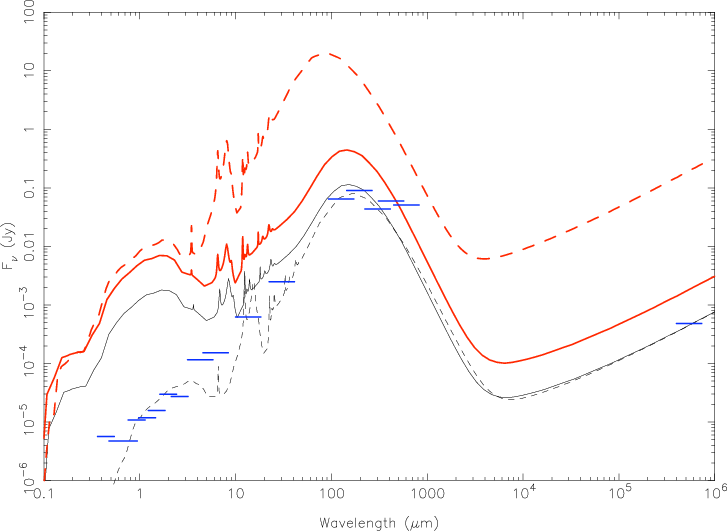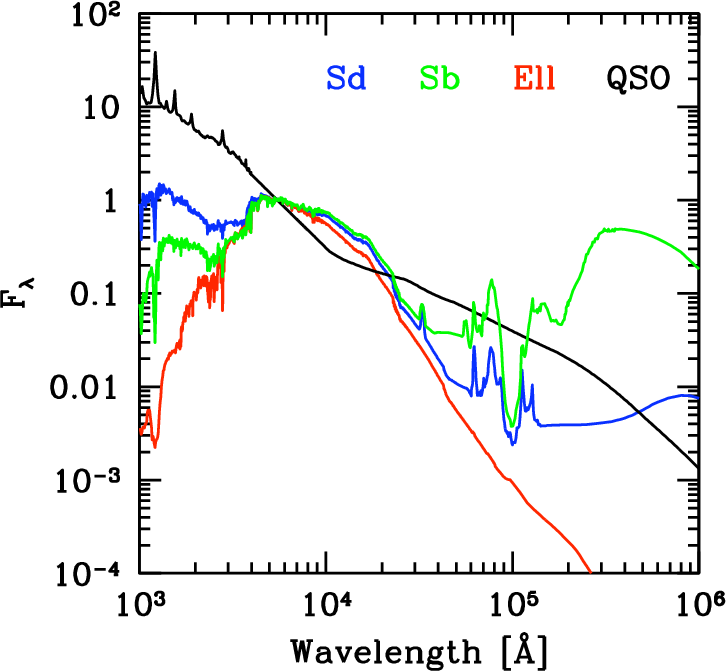

We now describe three ”real-life” examples of assembled multi-wavelength datasets. It would here be impossible to describe all existing datasets, we therefore chose just three that highlight different goals and methods.
The Local Volume Legacy (LVL) is a Spitzer legacy program built upon a foundation of GALEX ultraviolet and ground-based Hα imaging of 258 galaxies within 11 Mpc. The goal of the LVL survey is to fill a vital niche in existing multi-wavelength surveys of present-day galaxies with a statistically robust, approximately volume-complete study of our nearest star-forming neighbors. Although star formation rates based on optical spectroscopy as well as GALEX ultraviolet and Spitzer infrared imaging have been measured for many thousands of galaxies, most currently available datasets are derived from flux-limited samples, and thus suffer from well-known biases against low-mass, low surface brightness systems. Multi-wavelength datasets that do include such systems often only provide representative samples of this galaxy population (e.g., SINGS; Kennicutt et al. 2003), and are thus not suitable for studies that both seek to probe the low metallicity dwarf galaxy regime and require datasets which are true to the statistics rendered by volume-limited sampling. LVL consolidates and builds upon recent Local Volume galaxy surveys which have acquired ground-based narrowband Hα (Kennicutt et al. 2008), GALEX ultraviolet (Lee et al., in prep.) and HST resolved stellar population imaging (Dalcanton et al. 2009), by collecting Spitzer IRAC and MIPS infrared imaging for a sample of 258 galaxies derived from these programs. The collection of these observations enable a wealth of spatially-resolved and spatially-integrated studies probing present-day star formation, chemical abundance, stellar structure, and dust properties as well as galaxy evolution, particularly for metal-poor, low-mass galaxies which dominate the LVL sample by number. The coupling of the infrared and ultraviolet data in this survey are explored in Section 6.2.3.
ATLAS (Astrophysical Terahertz Large Area Survey) intends to provide the first unbiased survey of cool dust and obscured star formation in the local Universe. ATLAS will detect ~ 250,000 sources with a median redshift of ~ 1 over ~ 550 square degrees of sky in five bands covering the wavelength range 110-500 μm. The five photometric bands cover the peak of the dust SED for local galaxies and, crucially, can probe the cold dust component (T ≤ 20 K) which makes up ≃ 90% of the dust mass in most galaxies (Dunne and Eales 2001). Herschel can simultaneously provide an accurate measure of the bolometric far-infrared luminosity (related to the current star formation rate) and the total mass of dust (related to the gas mass). Figure 7 shows the improvements expected to be made to the measurements of the dust mass function and the need for a multi-wavelength approach to understanding the properties of galaxies.
The ATLAS will be unbiased as it does not rely on prior detection in other wavebands. Nevertheless, the ATLAS fields contain > 105 redshifts and are the best studied fields of this size; they are the targets of surveys being carried out with GALEX, VST, VISTA, UKIRT and the South Pole Telescope and will be the natural targets of many future surveys, including ones carried out by DES, WISE, LOFAR and the two SKA precursor telescopes in the south.


The greatest challenge for the Herschel ATLAS is likely to be the matching of the submillimeter sources to the correct optical / infrared counterparts. At very low redshift this is fairly straightforward as the density on the sky of bright optical galaxies is low enough that associations are unlikely to be random. At intermediate–high redshifts the number of potential matches increases dramatically and the large Herschel beam (18–36′′) means that correct identification cannot simply be a matter of probability and distance. This will require a multi-wavelength SED modeling code which can ‘join together’ the ultraviolet / optical / near-infrared portion of the spectrum with the far-infrared/submillimeter ‘bump’ in a self-consistent way.
Polletta et al. (2007) published a set templates that combine the SEDs of galaxies with those of AGN and thus fill an important hole in many SED fitting template sets2 . The library contains 20 templates including 1 elliptical, 7 spirals, 3 starbursts, 6 AGNs, and 3 composite (starburst+AGN) templates covering the wavelength range between 1000Å and 1000 μm. The elliptical, spiral and starburst templates were generated with the GRASIL code (Silva et al. 1998). Templates of moderately luminous AGN, representing Seyfert 1.8 and Seyfert 2 galaxies, were obtained by combining models, broad-band photometric data, and ISO-PHT-S spectra of a random sample of 28 Seyfert galaxies. Four additional AGN templates represent optically-selected QSOs with different values of infrared/optical flux ratios and one type 2 QSO. The QSO1 templates are derived by combining the SDSS quasar composite spectrum and rest-frame infrared data of a sample of SDSS/SWIRE quasars divided in three groups, all, and the 25% brightest and 25% weakest measurements per rest-frame wavelength bin. The type 2 QSO template (QSO2) represents the SED of the red quasar FIRST J013435.7-093102 (Gregg et al. 2002). The composite (AGN+SB) templates are empirical templates that well reproduce the SEDs of the following sources: the heavily obscured BAL QSO Mrk 231 (Berta 2005), the Seyfert 2 galaxy IRAS 19254-7245 South (Berta et al. 2003), and the Seyfert 2 galaxy IRAS 22491-1808 (Berta 2005).

While we presented above only three examples, the number of public datasets (potentially) useful for SED fitting is truly staggering. Many science projects can be carried out without ever writing an observing proposal, the prime example being use of the SDSS database. This is possible thanks to the work of a countless number of individuals on survey planning, data reduction and quality insurance. Below we provide a table of some of the major datasets, for exploration and further reading. We will keep a similar table online on sedfitting.org and we hope to expand it in the future.
| Acronym | Full name | Reference | Website | |||||
| AEGIS | All-wavelength Extended Groth Strip International Survey | Davis et al. (2007) | aegis.ucolick.org | |||||
| COMBO-17 | Classifying Objects by Medium-Band Observations | Wolf et al. (2003) | www.mpia.de/COMBO | |||||
| COSMOS | Cosmic Evolution Survey | Scoville et al. (2007) | cosmos.astro.caltech.edu | |||||
| GAMA | Galaxy And Mass Assembly | Driver et al. (2009) | www.eso.org/~jliske/gama | |||||
| GOLDMINE | Galaxy On Line Database Milano Network | Gavazzi et al. (2003) | goldmine.mib.infn.it | |||||
| GOODS | Great Observatories Origins Deep Survey | Giavalisco et al. (2004) | www.stsci.edu/science/goods | |||||
| LVL | Local Volume Legacy | Dale et al. (2009) | www.ast.cam.ac.uk/research/lvls/ | |||||
| MUSYC | Multiwavelength Survey by Yale-Chile | Taylor et al. (2009) | www.astro.yale.edu/MUSYC | |||||
| SDSS | Sloan Digital Sky Survey | Abazajian (2009) | www.sdss.org | |||||
| SINGS | Spitzer Infrared Nearby Galaxies Survey | Kennicutt et al. (2003) | sings.stsci.edu | |||||
| SSGSS | Spitzer SDSS GALEX Spectroscopic Survey | Treyer et al. (2010) | www.astro.columbia.edu/ssgss | |||||
| SWIRE | Spitzer Wide-area InfraRed Extragalactic survey | Lonsdale et al. (2003) | swire.ipac.caltech.edu | |||||
| VVDS | Vimos VLT Deep Survey | Le Fèvre et al. (2005) | cencosw.oamp.fr | |||||